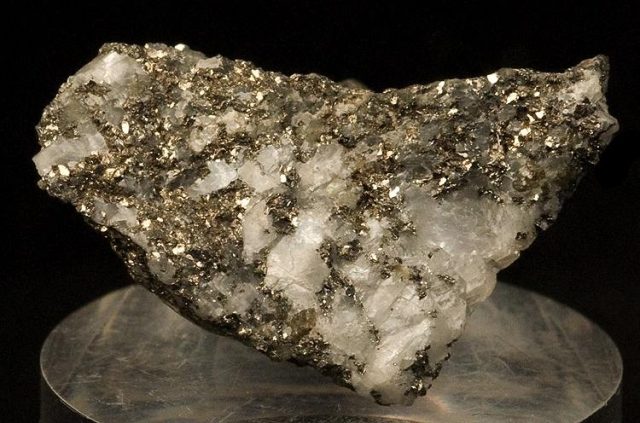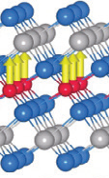Materials for raising the temperature of the quantized anomalous Hall and magnetoelectric effects

Topological insulators are electronic materials that have a bulk band gap like an ordinary insulator but have conducting states on their edge or surface. The conducting surface is not what makes topological insulators unique, but the fact that it is protected due to the combination of spin-orbit interactions and time-reversal symmetry.
Researchers are chasing efficient ways to break this time-reversal symmetry without using an external magnetic field, though. Actually, what they are trying to achieve is the realization of the quantum anomalous Hall effect, a quantized version of the anomalous Hall effect, and the topological magnetoelectric effect. But, what are these effects and why are they interesting?
Imagine that we have a conductor or a semiconductor through which a current is flowing. Then we apply a strong transverse magnetic field. As a result, we can measure a potential difference at right angles to both the current and the field caused by the deflection of charge carriers by the field. This effect was described by Edwin Hall in 1879 and is the classical Hall effect. It introduces a coefficient which is a constant characteristic of the material. A quantum mechanical version of the Hall effect can be found at very low temperatures, in this the Hall coefficient is quantized. In the anomalous version of the quantum Hall effect, the anomaly is that a finite Hall voltage is present even in the absence of an external magnetic field.
The quantum anomalous hall state is characterized by a dissipationless edge mode carrying electrons of only one spin direction. This unique effect represents a promising platform for the creation of next-generation low power consumption electronic devices as well as for incarnation of novel phenomena like Majorana fermions.
On the other hand, if the insulator film is thick enough as to eliminate the finite-size effect, the quantized topological magnetoelectric effect will appear. This means that an electric field would induce a topological contribution to the magnetization with a quantized universal coefficient of proportionality. This effect can open the door to magnetic monopoles.
Exciting, isn’t it? Unfortunately, being realized very recently, these effects are only accessible at extremely low temperatures (2 K) and the lack of appropriate materials that would enable the temperature increase is a most severe challenge. New ideas are badly needed.
Now, a work 1 lead by researchers from DIPC, CFM and UPV/EHU propose a novel material platform with an unique combination of properties making it perfectly suitable for the realization of both effects at elevated temperatures. Using first-principles calculations, the team develops a new, simple and efficient method to incorporate magnetism in topological insulator surfaces that avoids dopant distribution and metallization problems, and suggests and discusses different specific systems.

Thus, using ab initio band structure calculations, the researchers propose a magnetic extension of topological insulator surfaces—a novel approach for the time reversal symmetry breaking. The key idea behind it is the use of topological and magnetic insulators of the allied crystal structure and similar atomic composition, such that the surface features of the former are naturally extended upon the deposition of the latter. In this case, the topological surface state does not meet any significant interfacial potential and largely penetrates into the magnetically-extended part, getting gigantically split once the ferromagnetic state with an out-of-plane magnetization onsets there.
The researchers study systems consisting of tetradymite-type nonmagnetic semiconductor films (Bi2Te3, Sb2Te3, and others) of different thicknesses, sandwiched between two septuplelayer-thick films of a tetradymite-family magnetic insulator like MnBi2Te4.
The approach relies on the use of the stoichiometric magnetic compounds thus ruling out possible disorder-related effects. Such a combination of properties renders the magnetically-extended topological insulator surface to be a unique system, perfectly suitable for the eventual experimental observation of the topological magnetoelectric effect at topological insulator surfaces without a magnetic field, as well as for the realization of the quantum anomalous Hall state significantly beyond temperatures reached to date.
Author: César Tomé López is a science writer and the editor of Mapping Ignorance.
References
- M M Otrokov, T V Menshchikova, M G Vergniory, I P Rusinov, A Yu Vyazovskaya, Yu M Koroteev, G Bihlmayer, A Ernst, P M Echenique, A Arnau and E V Chulkov (2017) Highly-ordered wide bandgap materials for quantized anomalous Hall and magnetoelectric effects 2D Mater. 4 – 025082 doi: 10.1088/2053-1583/aa6bec ↩
2 comments
[…] Etorkizuneko elektronikaren eta espintronikaren eremuan material berriek eskaintzen dituzten aukerak sinesgaitzak dira. Energia kantitate arbuiagarriak erabiltzeko aukera, esaterako. Horretarako, baina, materialak deiseinatu behar dira. Adibide zoragarria DIPCren eskutik: Materials for raising the temperature of the quantized anomalous Hall and […]
[…] Las posibilidades que ofrecen los nuevos materiales para la electrónica y espíntrónica del futuro son increíbles. Como la posibilidad de que consuman cantidades ridículamente bajas de energía. Pero para ello hay que diseñar los materiales. Un magnífico ejemplo por […]